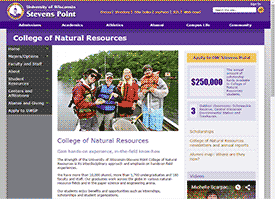Standards
University Communications and Marketing (UCM) maintains a
Communications Standards Manual that provides guidance on creating a clear, consistent style in all external communications both in writing style and appearance. Having a clearly defined, consistent style strengthens UW-Stevens Point's reputation and image. Be sure to look over the guide and refer to it if you have any questions while creating your website. Summarized below are the web-related and web-specific standards. If you have any questions about language or what kinds of content you should have on your site contact UCM for assistance.
Web Color Palette
Below is the UW-Stevens Point print colors translated into web hexidecimal values. Small adjustments to color saturation or brightness may be necessary when using the palette colors on web pages to allow for variation in display devices and to pass WCAG
accessibility standards. There must be adequate contrast between foreground and background colors for good readability.
#512698
Purple
#FFC82e
Gold
Fonts for the Web
The site's default stylesheet sets the fonts for the website. The heading and body text font is Arimo. This is written in CSS as
font-family: Arimo, Verdana, Arial, Helvetica, sans-serif;
Webpages use the fonts installed on the user's computer, tablet, or phone to render the webpage text. Since we can't know for certain what fonts are installed on the user's machine, we provide the browser with a priority list of fonts to use. The above code means if Verdana is available use that to render the text, if not use Arial, if Arial is not available use Helvetica, if Helvetica is not available use whatever is set as the default sans-serif font in the browser. It is
not a list of fonts you can choose from to set your site's font. Verdana is installed with most operating systems and is almost always available. The one notable exception to this is a stock Android OS install, it has fonts not commonly found in other OSs.
Some exceptions may be made for using a serif font. Times New Roman is the preferred serif font. Georgia is also acceptable as a second choice for a serif font. These should be written in your CSS as:
font-family: Times New Roman, Times, serif;
font-family: Georgia, Times, New Roman, Times, serif;
Responsive Break Points
www.uwsp.edu has been designed and coded to be responsive. In a web context "responsive" means that instead of having separate websites for desktop/laptop computers and phones/tablets we have one website that changes its layout based on the window or screen size it is displayed on.

A break point is the width at which we purposefully change the page layout to accomodate the smaller or larger screen size. The break-points for www.uwsp.edu are at 960px, 767px, and 500px.
@media screen and (max-width: 960px) {}
@media screen and (max-width: 767px) {}
@media screen and (max-width: 500px) {}
You may use whatever breakpoints will work best to deliver your content to different devices, but be aware that the overall site and page layout may change at 960px, 767px, or 500px.
Vanity URLs
UW-Stevens Point has the ability to create “vanity” Web addresses as aliases to Web materials. This allows a page with a “real” name such as www.uwsp.edu/Dept/MyName/index.html to be accessed via a name of the form www.uwsp.edu/ShortenedName. This not only results in a shorter name but also can eliminate much confusion when communicating a Web address orally.
Requests for Vanity URLs
The following guidelines apply to such aliases:
- All such URLs will be of the form www.uwsp.edu/ShortenedName where ShortenedName is chosen to denote the unit or function to whose home page the vanity URL refers.
- The ShortenedName chosen must be unique enough to unambiguously indicate the UW-Stevens Point unit or program involved (e.g. avoiding acronyms or key words that are shared with other UW-Stevens Point entities).
- Any unit of UW-Stevens Point down to the level of department/center/institute may have one such URL directed to its home page.
- Any department offering a degree program with a name that differs from that of the department may have a vanity URL directed to that degree program’s materials.
- Any SIEO-recognized student organization may have one such URL directed to its home page.
- Requests for URLs for purposes other than the above (e.g., for special publications or activities) will be considered on a case-by-case basis. Key decision points include that a significant off-campus audience is at stake, and that the unit’s own URL would not be appropriate to reach that audience.
- New URLs will only be created for pages that are fully in compliance with current university standards (accessibility and appropriate branding).
File naming conventions
When you create webpages name them using full english words or phrases, and name them something that accurately reflects the contents of that page, replace spaces with a hyphen. The file name is another piece of information used by search engines to determine what your page is about. Accurate and descriptive names help search engines correctly index our content so we can be found in searches. It also is helpful when browsing through your pages library you'll be able to see at a glance what each page is about.
Example
Let's say you're making a page for a scholarship directory, here's an example of how you could name it.
Bad: sclrshpdir.aspx
Bad: ScholarshipDirectory.aspx
Good: scholarship-directory.aspx
The same principle applies to other kinds of files as well.
